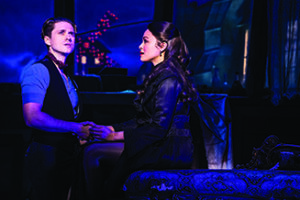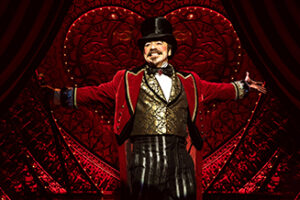Moulin Rouge! The Musical
Al Hirschfeld Theatre, NYC, August 1, 2019
Reviewed by Elizabeth Ahlfors for Cabaret Scenes
Photos by Matthew Murphy

Moulin Rouge! is more than a nightclub. In the words of Harold Zidler, the emcee and impresario of the legendary night spot extraordinaire in Paris during the Belle Époque, it “is a state of mind. It is that part of your soul which throbs and pulses; it is that corner of your mind where your fantasies live.” Currently commanding Broadway’s Al Hirschfeld Theatre, Moulin Rouge! is a fantasy, a jukebox romance with songs by songwriters not yet born in the period in whichit is set.
Based on Baz Luhrmann’s 2001 film, Moulin Rouge!, the theatrical version was directed by Alex Timbers with hyperbolic flair. Set designer Derek McLane and lighting designer Justin Townsend dazzle with lush velvet, satin and sequins, mismatched chandeliers, a looming blue elephant statue, and a sparkling scarlet and gold Red Mill, all landmarks of bohemian Montmartre. Catherine Zuber’s costumes are a lucky diva’s best friend featuring black fishnet stockings, garters, and sparkling strips of cloth. These change dramatically when the scene switches to the Avenue des Champs-Élysées where the Parisian haute société stroll in lush satin visions of pale violet and pink.
Come early enough to absorb the fin de siècle decadent grandiosity that transforms the theater. Follow the pre-show action, aimed at enticing rich men to spend, spend, spend. In hypnotic slow-motion, sinuous young men swish seductively around the redesigned side balconies, statuesque show-girls swan across the stage from one ornate balcony to the other, stopping to pose and be seen and photographed. All this happens before the curtain rises on the renowned turn-of-the-century Parisian nightclub, with latticed layers of scarlet hearts framing the stage.

Can-can dancers in twirling skirts kick-start John Logan’s overstuffed book. First meet Zidler, who manages and manipulates what goes on and what doesn’t in that struggling club. Zidler is played by Danny Burstein with wicked flair and cunning. (Is there anything Burstein cannot do?) He shows tough intensity; his plate is full as he juggles solving money problems at the Moulin Rouge and flim-flamming performers and customers.
Zidler decides that a possible way out of bankruptcy is by finessing his “Sparkling Diamond,” Satine (Karen Oliva), into pleasuring the handsome, wealthy, but dissolute Duke of Monroth (Tan Mutu). The Duke’s arrival announces “a man of wealth and taste” (“Sympathy for the Devil”). Satine is resplendant in her descent from the rafters on a swing, and she joins a quartet of sexy dancers (Jacqueline R. Arnold, Robyn Norder, Holly James, Leigh Madjus) for “Diamonds Are a Girl’s Best Friend,” followed by “Material Girl,” and “Single Ladies (Put a Ring On It).”
But Satine faces problems ahead since she is soon to fall in love with a poor but earnest songwriter from Ohio, Christian (Aaron Tveit). Christian lives in a garret with two chums, Toulouse-Lautrec and Santiago, played with juicy panache by Sahr Ngaujah and Ricky Rojas, respectively. When they splurge on a visit to the Moulin Rouge, Christian falls desperately in love with Satine. (He also wants her to star in a show the three roomies are writing). This is a love she returns with trepidation. Understandably, Zidler demands she dump Christian and do her duty with the Duke to benefit the Moulin Rouge.
Remember, this is a fantasy, so expect hidden romance, whispered plans, mistaken identities, and then one more twist. Besides Satine’s responsibilities to Zidler and her fellow chorus girls as well as her yearning for the hunky young Christian, she faces another problem—her incessant coughing that is followed by tell-tale blood on the handkerchief, spelling consumption. How can we not think of La Bohéme, La Traviata, Rent?
The young leads, Oliva and Tveit, while fine singers, fail as lovers, barely raising their chemistry to simmering, and even then, it continues to lose warmth by the end.
Most of the 70 numbers are mashups aimed to boost the love story of Satine and Christian who share Elton John’s “Your Song,” as their song. The familiarity of mostly 1970s and ’80s songs set into a romance from 100 years earlier delights most audience members. Sonya Tayeh’s choreography for “Bad Romance,” “Seven Nation Army,” and “Tainted Love,” demands athleticism and skill by the entire ensemble. A 14-person orchestra under conductor Cian McCarthy raises the high decibel level set by sound designer Peter Hylenski.
Moulin Rouge! is the ticket to start saving for if you have a yen for a dizzying ride of excess, exaggeration, and jukebox tunes. While it spills over with romance, pathos, and decadence, sword-swallowing showgirls and lithe young men, at the heart of Moulin Rouge! is the doomed bohemian cry of “Freedom, Beauty, Truth, and Love!”





